Abstract
Background:
Skin grafts are required in numerous clinical procedures, such as reconstruction after skin removal and correction of contracture or scarring after severe skin loss caused by burns, accidents, and trauma. The current standard for skin defect replacement procedures is the use of autologous skin grafts. However, donor-site tissue availability remains a major obstacle for the successful replacement of skin defects and often limits this option. The aim of this study is to effectively expand full thickness skin to clinically useful size using an automated skin reactor and evaluate auto grafting efficiency of the expanded skin using Yucatan female pigs.
Methods:
We developed an automated bioreactor system with the functions of real-time monitoring and remote-control, optimization of grip, and induction of skin porosity for effective tissue expansion. We evaluated the morphological, ultra-structural, and mechanical properties of the expanded skin before and after expansion using histology, immunohistochemistry, and tensile testing. We further carried out in vivo grafting study using Yucatan pigs to investigate the feasibility of this method in clinical application.
Results:
The results showed an average expansion rate of 180%. The histological findings indicated that external expansion stimulated cellular activity in the isolated skin and resulted in successful grafting to the transplanted site. Specifically, hyperplasia did not appear at the auto-grafted site, and grafted skin appeared similar to normal skin. Furthermore, mechanical stimuli resulted in an increase in COL1A2 expression in a suitable environment.
Conclusions:
These findings provided insight on the potential of this expansion system in promoting dermal extracellular matrix synthesis in vitro. Conclusively, this newly developed smart skin bioreactor enabled effective skin expansion ex vivo and successful grafting in vivo in a pig model.










Similar content being viewed by others
References
Cubo N, Garcia M, Del Cañizo JF, Velasco D, Jorcano JL. 3D bioprinting of functional human skin: production and in vivo analysis. Biofabrication. 2017;9:015006.
Andreassi A, Bilenchi R, Biagioli M, D’Aniello C. Classification and pathophysiology of skin grafts. Clin Dermatol. 2005;23:332–7.
Loss M, Wedler V, Künzi W, Meuli-Simmen C, Meyer VE. Artificial skin, split-thickness autograft and cultured autologous keratinocytes combined to treat a severe burn injury of 93% of TBSA. Burns. 2000;26:644–52.
Sheridan R. Closure of the excised burn wound: autografts, semipermanent skin substitutes, and permanent skin substitutes. Clin Plast Surg. 2009;36:643–51.
Cai SJ, Li CW, Weihs D, Wang GJ. Control of cell proliferation by a porous chitosan scaffold with multiple releasing capabilities. Sci Technol Adv Mater. 2017;18:987–96.
Mandal BB, Kundu SC. Cell proliferation and migration in silk fibroin 3D scaffolds. Biomaterials. 2009;30:2956–65.
Sadeghi-Avalshahr A, Nokhasteh S, Molavi AM, Khorsand-Ghayeni M, Mahdavi-Shahri M. Synthesis and characterization of collagen/PLGA biodegradable skin scaffold fibers. Regen Biomater. 2017;4:309–14.
Vig K, Chaudhari A, Tripathi S, Dixit S, Sahu R, Pillai S, et al. Advances in skin regeneration using tissue engineering. Int J Mol Sci. 2017;18:E789.
Law JX, Liau LL, Saim A, Yang Y, Idrus R. Electrospun collagen nanofibers and their applications in skin tissue engineering. Tissue Eng Regen Med. 2017;14:699–718.
Park TH, Choi WY, Lee JH, Lee WJ. Micronized cross-linked human acellular dermal matrices: an effective scaffold for collagen synthesis and promising material for tissue augmentation. Tissue Eng Regen Med. 2017;14:517–23.
Spence RJ. Clinical use of a tissue expander–enhanced transposition flap for face and neck reconstruction. Ann Plast Surg. 1988;21:58–64.
Ladd MR, Lee SJ, Atala A, Yoo JJ. Bioreactor maintained living skin matrix. Tissue Eng Part A. 2009;15:861–8.
Huh MI, An SH, Kim HG, Song YJ, Choi EC, An SH, et al. Rapid expansion and auto-grafting efficiency of porcine full skin expanded by a skin bioreactor ex vivo. Tissue Eng Regen Med. 2016;13:31–8.
Vidmar J, Chingwaru C, Chingwaru W. Mammalian cell models to advance our understanding of wound healing: a review. J Surg Res. 2017;210:269–80.
Guo S, Dipietro LA. Factors affecting wound healing. J Dent Res. 2010;89:219–29.
Bullough WS, Laurence EB. The control of epidermal mitotic activity in the mouse. Proc R Soc Lond B Biol Sci. 1960;151:517–36.
Lorber M, Milobsky SA. Stretching of the skin in vivo. A method of influencing cell division and migration in the rat epidermis. J Invest Dermatol. 1968;51:395–402.
Mackenzie IC. The effects of frictional stimulation on mouse ear epidermis. II. Histologic appearance and cell counts. J Invest Dermatol. 1974;63:194–8.
Curtis AS, Seehar GM. The control of cell division by tension or diffusion. Nature. 1978;274:52–3.
Vandenburgh HH. Mechanical forces and their second messengers in stimulating cell growth in vitro. Am J Physiol. 1992;262:R350–5.
Lancerotto L, Orgill DP. Mechanoregulation of angiogenesis in wound healing. Adv Wound Care (New Rochelle). 2014;3:626–34.
Ingber DE. Tensegrity II. How structural networks influence cellular information processing networks. J Cell Sci. 2003;116:1397–408.
Pietramaggiori G, Liu P, Scherer SS, Kaipainen A, Prsa MJ, Mayer H, et al. Tensile forces stimulate vascular remodeling and epidermal cell proliferation in living skin. Ann Surg. 2007;246:896–902.
Jeong C, Chung HY, Lim HJ, Lee JW, Choi KY, Yang JD, et al. Applicability and safety of in vitro skin expansion using a skin bioreactor: a clinical trial. Arch Plast Surg. 2014;41:661–7.
Xue M, Jackson CJ. Extracellular Matrix reorganization during wound healing and its impact on abnormal scarring. Adv Wound Care (New Rochelle). 2015;4:119–36.
Ghaffari A, Kilani RT, Ghahary A. Keratinocyte-conditioned media regulate collagen expression in dermal fibroblasts. J Invest Dermatol. 2009;129:340–7.
Callaghan TM, Wilhelm KP. A review of ageing and an examination of clinical methods in the assessment of ageing skin. Part I: cellular and molecular perspectives of skin ageing. Int J Cosmet Sci. 2008;30:313–22.
Uehara E, Hokazono H, Hida M, Sasaki T, Yoshioka H, Matsuo N. GABA promotes elastin synthesis and elastin fiber formation in normal human dermal fibroblasts (HDFs). Biosci Biotechnol Biochem. 2017;81:1198–205.
Mithieux SM, Weiss AS. Design of an elastin-layered dermal regeneration template. Acta Biomater. 2017;52:33–40.
Kielty CM, Sherratt MJ, Shuttleworth CA. Elastic fibres. J Cell Sci. 2002;115:2817–28.
Acknowledgements
This research was supported by 2017 Medical Cluster R&D Support Project through Daegu Gyeongbuk Medical Innovation Foundation funded by the Ministry of Health and Welfare, the Republic of Korea (HI16C2505), and ETRI R&D Program [15ZC3110, Local-based medical device/robot development and medical IT convergence for small and medium enterprises revitalization project].
Author information
Authors and Affiliations
Corresponding author
Ethics declarations
Conflicts of interest
The authors declare that there is no conflict of interest regarding the publication of this paper.
Ethical statement
Animal care and experimental procedures were approved by the Institutional Animal Care and Use Committee at DGMIF (DGMIF-16100301-01, Daegu-Gyeongbuk Medical Innovation Foundation, Daegu, Korea).
Rights and permissions
About this article
Cite this article
Huh, MI., Yi, SJ., Lee, KP. et al. Full Thickness Skin Expansion ex vivo in a Newly Developed Reactor and Evaluation of Auto-Grafting Efficiency of the Expanded Skin Using Yucatan Pig Model. Tissue Eng Regen Med 15, 629–638 (2018). https://doi.org/10.1007/s13770-018-0154-6
Received:
Revised:
Accepted:
Published:
Issue Date:
DOI: https://doi.org/10.1007/s13770-018-0154-6




